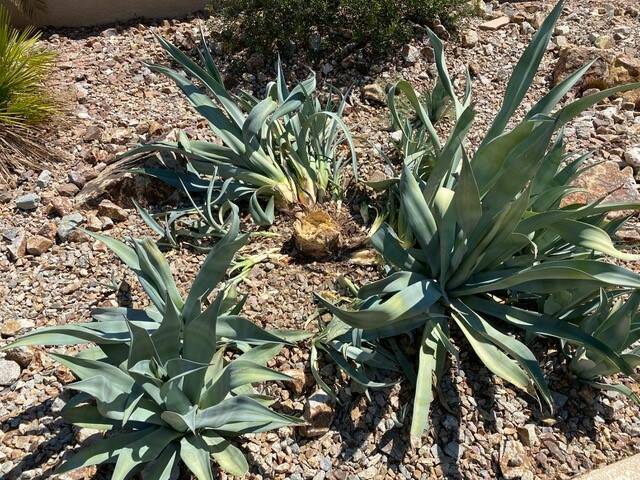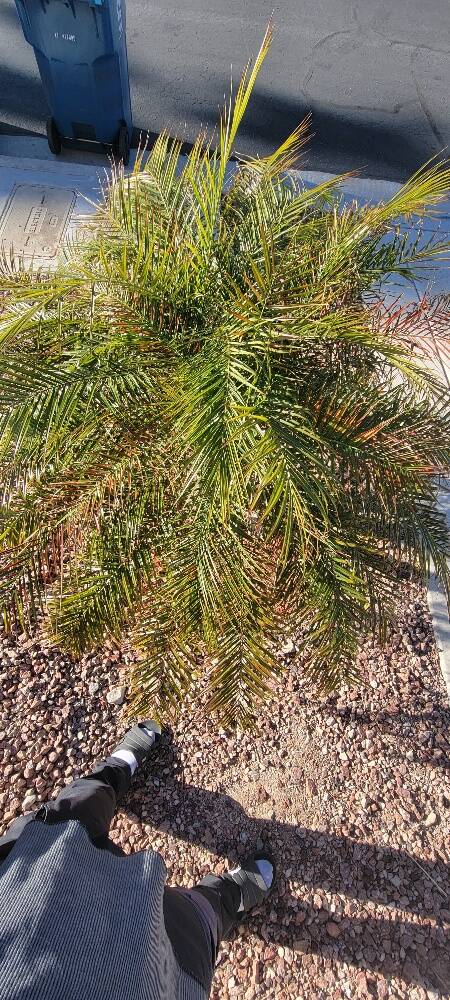Freezing temperatures can damage pygmy date palm
Q: My pygmy date palm I recently planted in the front yard has brown fronds. What happened?
A: I am guessing you got temperatures below 30 degrees this winter, possibly coupled with some strong wind. There is some bad information on the internet saying that pygmy date palm can handle temperatures to 22 degrees. That’s not true. It’s more like about 28 degrees. Freezing temperatures — and possibly wind — account for the brown fronds that you’re seeing.
Pygmy date palm is from Southeast Asia and grows best in warmer temperatures with improved soils and surrounded with decomposing debris. That’s a fancy way of saying “woodchips” on the soil surface after it’s planted. Not rock.
It’s planted in the front yard with no protection from the wind. Streets, particularly north and south running streets, are like urban canyons that funnel the wind.
This is a palm with delicate fronds like a queen palm. The fronds are going to get damaged by strong winds. When you get freezing temperatures combined with wind and a tropical palm, this can create havoc — a lot of winter or freezing damage.
If you are going to plant a pygmy date palm here, expect to see some brown leaves during cold winters. Instead plant pygmy date palm on the east side of a home, with shade in the afternoon, and not in full sunlight on the south or west side.
It must be planted in soil with about 20 to 30 percent compost mixed with it. At 20 to 30 percent compost, the planting mixture should be dark brown or nearly black.
Q: I had several of my Mangaves shriveling and dying this winter. The babies around each were fine. I expected to see some grubs inside when I pulled the plants up, but rather I found some black bugs resembling earwigs inside. I used grub systemic on these plants; that must be working as there were no grubs present. Are these black bugs what’s eating the stems? And are they immune to systemic poisoning?
A: Mangaves are basically agaves; a cactus. A mangave is a cross between an agave and another group of agaves called the manfreda group.
Treat your plants like an agave. They are susceptible to early summer damage from the agave snout weevil. This is a 3/8-inch-long black weevil that lays its eggs at the base of agave leaves and damages the plant’s stem and roots.
It’s theorized that agaves with wider leaves, like American agave, are more attractive to the egg-laying of the female weevil than those agaves with narrower leaves. Some wider leaved yuccas are also damaged by this insect or close relative.
It’s possible these black bugs are feeding on the leftover dead plant rather than causing the problem. The systemic insecticide for controlling agave snout weevil should be applied in late March or April each year to control snout weevil damage.
Finding insects this time of year means they are probably not snout weevils. Without this damage being created, I don’t think you’ll have any problem with the black bugs you’re talking about.
Q: I live in southern Utah, and we get freezing temperatures numerous times during the winter months. Is there a Meyer lemon tree that can be pot planted and brought indoors in late November that will produce fruit? If so, what would be the best variety?
A: Meyer lemon can handle temperatures to 25 degree when it’s young and a bit more than that if it’s older, but it can’t handle wind plus freezing temperatures when it is young. If you bring it indoors, bring it in when temperatures start freezing.
If it’s at all possible, take it outside again if there is a warm spell and bring it back in when it turns colder. Use your phone app to predict upcoming warm weather.
Outside plants will not like being held inside in warm temperatures for several days in a row and then taken back outside again. The plant will get confused.
Meyer lemon is a rather large citrus. If you’re going to move it around, I would suggest a smaller citrus like a lime rather than Meyer lemon. Lime trees stay smaller and are easier to move.
Meyer lemon doesn’t have any varieties. It’s just Meyer lemon. You can look for Improved Meyer lemon but that’s it. Meyer is not a true lemon, by the way, but looks and tastes like one.
Q: I live in southern Utah, and I planted a pomegranate bush this past fall and need some input on how to best care for it.
A: The major problem you’ll have with growing pomegranates in southern Utah is winter cold temperatures from about Dec. 1 through the end of February. Freezing temperatures start at 32 degrees can get much lower than that.
Pomegranates can handle winter temperatures to about 15 to 20 degrees. Some varieties are more sensitive to winter cold than others. They can handle windy locations and can serve as a windbreak for other fruit trees.
Stay with the more known cold-hardy varieties of pomegranate like Wonderful, Sweet, Utah Sweet and a newer introduction called Parfianka. Plant it in a warm microclimate in the yard. Until more is known about how cold-hardy some varieties might be, temperatures to about 15 to 20 degrees should suffice.
As far as growing them, they like full sun, occasional watering, improved soil and wood chips surrounding them. Fertilize them a single time in early spring, about March or April, when they first wake up.
They flower and fruit on new growth. When their fruit is enlarging, they don’t like any shortages in the watering at all or the fruit will split after water is resupplied. In our Las Vegas climate, fruit is hand picked, depending on the variety, anywhere from September until Halloween. Each variety is harvested during different months.
Q: About six years ago, I brought back from Tucson a pup saguaro cactus about 2 to 3 inches tall and potted it. I bring the pot indoors when the nights start to get cold. It’s done very well. After two years, it sprouted an appendage. At this point it has several arms starting to grow, and I’m beginning to wonder if it is, in fact, a saguaro.
A: I can understand your doubt. I’m not a saguaro expert by any stretch of the imagination but I doubt it as well. Normally saguaros grow 6 or 7 feet tall and then start growing their arms. Saguaro flowers are normally white while the fruit is normally red, but it’s possible also to be green.
It’s possible you got a Ferocactus. Many have red flowers and are one of the barrel cacti and resemble saguaro when young.
Q: I have a raised veggie garden on the south side of my house. That was the only place we had to put it. I have not had much luck with eggplant, peas, broccoli, zucchini and minimal success with tomatoes. The only thing I get a lot of is carrots. Do you have any suggestions of what to plant and how to get better results?
A: I am guessing that’s a very hot location particularly if it’s close to a south-facing wall. If it’s in a hot location, scheduling the raised bed could be four to six weeks earlier than normal.
Producing veggies in that area follows a similar calendar to a cooler spot but just earlier. It’s best to use a recording thermometer, but my guess is that it’s a very warm area.
You really won’t know much until you get an idea of what winter temperature you’re talking about. This location might never freeze, and it might be a great place to grow tomatoes from January until about March or early April. Consider also getting a soil thermometer.
Get a recording maximum-minimum thermometer in that spot and track the temperatures. Tracking the temperatures will tell you when you can plant safely.
My guess is it’s too hot in the summertime for that location during normal calendar times. You may need a second raised bed in a cooler spot in the yard like on the east side of a building or east side of your home.
Bob Morris is a horticulture expert and professor emeritus of the University of Nevada, Las Vegas. Visit his blog at xtremehorticulture.blogspot.com. Send questions to Extremehort@aol.com.



















